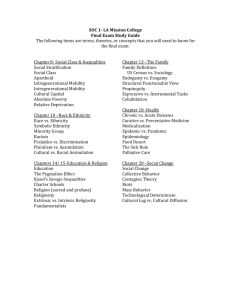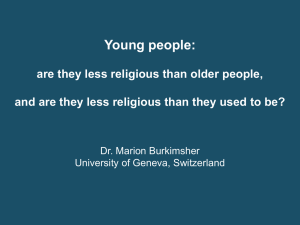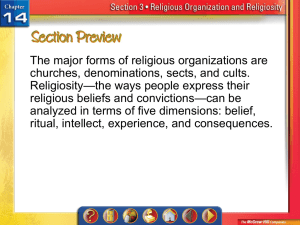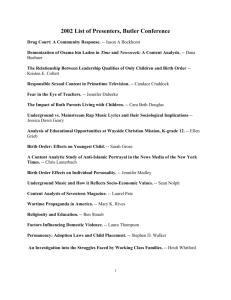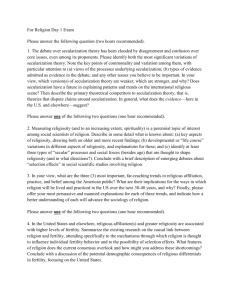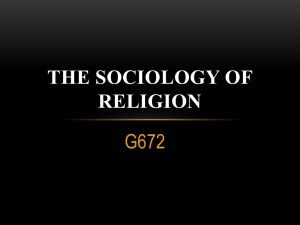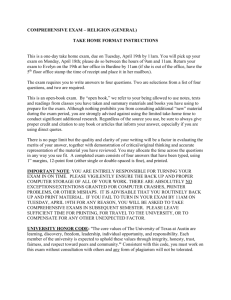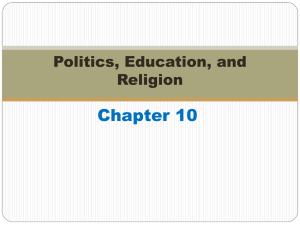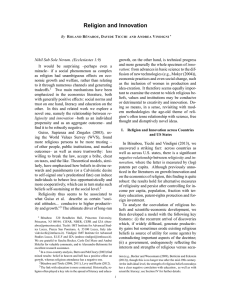Document 10464527
advertisement
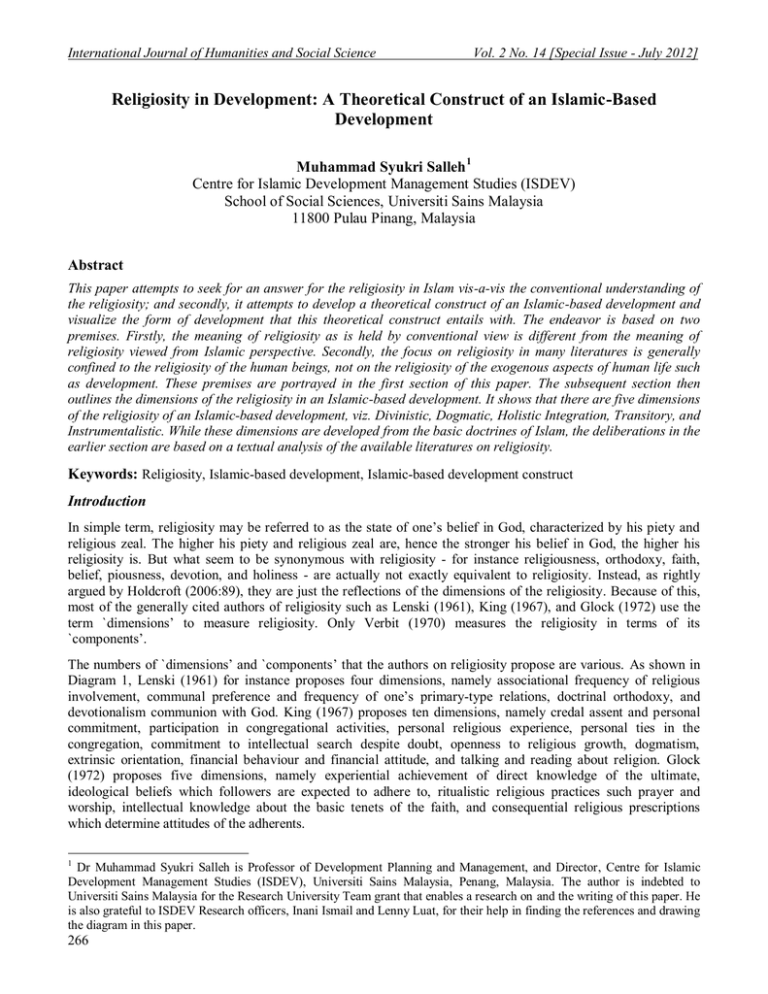
International Journal of Humanities and Social Science Vol. 2 No. 14 [Special Issue - July 2012] Religiosity in Development: A Theoretical Construct of an Islamic-Based Development Muhammad Syukri Salleh 1 Centre for Islamic Development Management Studies (ISDEV) School of Social Sciences, Universiti Sains Malaysia 11800 Pulau Pinang, Malaysia Abstract This paper attempts to seek for an answer for the religiosity in Islam vis-a-vis the conventional understanding of the religiosity; and secondly, it attempts to develop a theoretical construct of an Islamic-based development and visualize the form of development that this theoretical construct entails with. The endeavor is based on two premises. Firstly, the meaning of religiosity as is held by conventional view is different from the meaning of religiosity viewed from Islamic perspective. Secondly, the focus on religiosity in many literatures is generally confined to the religiosity of the human beings, not on the religiosity of the exogenous aspects of human life such as development. These premises are portrayed in the first section of this paper. The subsequent section then outlines the dimensions of the religiosity in an Islamic-based development. It shows that there are five dimensions of the religiosity of an Islamic-based development, viz. Divinistic, Dogmatic, Holistic Integration, Transitory, and Instrumentalistic. While these dimensions are developed from the basic doctrines of Islam, the deliberations in the earlier section are based on a textual analysis of the available literatures on religiosity. Keywords: Religiosity, Islamic-based development, Islamic-based development construct Introduction In simple term, religiosity may be referred to as the state of one‟s belief in God, characterized by his piety and religious zeal. The higher his piety and religious zeal are, hence the stronger his belief in God, the higher his religiosity is. But what seem to be synonymous with religiosity - for instance religiousness, orthodoxy, faith, belief, piousness, devotion, and holiness - are actually not exactly equivalent to religiosity. Instead, as rightly argued by Holdcroft (2006:89), they are just the reflections of the dimensions of the religiosity. Because of this, most of the generally cited authors of religiosity such as Lenski (1961), King (1967), and Glock (1972) use the term `dimensions‟ to measure religiosity. Only Verbit (1970) measures the religiosity in terms of its `components‟. The numbers of `dimensions‟ and `components‟ that the authors on religiosity propose are various. As shown in Diagram 1, Lenski (1961) for instance proposes four dimensions, namely associational frequency of religious involvement, communal preference and frequency of one‟s primary-type relations, doctrinal orthodoxy, and devotionalism communion with God. King (1967) proposes ten dimensions, namely credal assent and personal commitment, participation in congregational activities, personal religious experience, personal ties in the congregation, commitment to intellectual search despite doubt, openness to religious growth, dogmatism, extrinsic orientation, financial behaviour and financial attitude, and talking and reading about religion. Glock (1972) proposes five dimensions, namely experiential achievement of direct knowledge of the ultimate, ideological beliefs which followers are expected to adhere to, ritualistic religious practices such prayer and worship, intellectual knowledge about the basic tenets of the faith, and consequential religious prescriptions which determine attitudes of the adherents. 1 Dr Muhammad Syukri Salleh is Professor of Development Planning and Management, and Director, Centre for Islamic Development Management Studies (ISDEV), Universiti Sains Malaysia, Penang, Malaysia. The author is indebted to Universiti Sains Malaysia for the Research University Team grant that enables a research on and the writing of this paper. He is also grateful to ISDEV Research officers, Inani Ismail and Lenny Luat, for their help in finding the references and drawing the diagram in this paper. 266 The Special Issue on Social Science Research © Centre for Promoting Ideas, USA www.ijhssnet.com Glock‟s dimensions have been expanded by at least four other works on religiosity, viz. by Stark and Glock (1968), Faulkner and DeJong (1966), Nudelman (1971), and O‟Connell (1975) 2. Apart from the above authors, others such as Fukuyama (1960), for instance, proposes four dimensions (cognitive, cultic, creedal, and devotional), Allport and Ross (1967) identifies two basic dimensions (extrinsic and intrinsic), Bergan and McConatha (2000) proposes a number of dimensions associated with religious beliefs and involvement, and Ellison et al. (1989) examines three dimensions (private devotion, religious attendance, and denominational connection). Ellison (1991) later expanded on and examined four dimensions of religiosity (denominational ties, social integration, personal sense of the divine, and existential certainty) 3. Of all the authors, only Verbit (1970) seems to be the only one who does not use the term „dimensions‟. Instead, he uses the term „components‟. He proposes six components of religiosity, namely ritual, doctrine, emotion, knowledge, ethics, and community. Nevertheless, he uses component just as a term in which dimensions are embedded in. He believes that „religion has several „components‟, and an individual‟s behavior vis-à-vis each one of these components has a number of „dimensions‟4. However, all in all irrespective of the terms, the core dimensions and components of the religiosity proposed by these authors could be observed to have included, thus could be categorized into, four main things. They are belief, knowledge, practice and experience. The higher these four categories of the dimensions and components are, the higher the one‟s religiosity is. These belief, knowledge, practice and experience of religiosity are undoubtedly could also be used to measure the religiosity in Islam. But when it comes to specific dimensions and components, as will be shown later, they have to be different. The dimensions and components developed by the above authors are based predominantly on their studies on Christian believers and manifestations of Christian religious experience. It is therefore questionable whether these methodological approaches can explain non-Christian religious experience in general and manifestations of Islamic orientation in particular. In the case of the religiosity in development, not only the relevancy of the conventional dimensions and components are questionable, but even if the dimensions and components are in line with the Islamic thought, their application is also different. The above dimensions and components are meant for human‟s religiosity, while in the case of development, it is meant for an aspect of human‟s need. While the former deals with human-self, the later deals with an exogenous factor of the human-self. Someone with a high degree of religiosity measured by the above dimensions and components could be regarded as a `religious person‟. But could one term the same for a development endeavor based on a high degree of religiosity? It is definitely could not be termed as a `religious development‟. Instead, it could be termed as an `Islamic-based development‟, if the religiosity is based on Islamic doctrines, portraying 2 For a discussion on the dimensions and components of religiosity proposed by these authors, see Küçükcan (2000). On the discussions on the ideas of these authors, see Holdcroft (2006). 4 The scientific study on religiosity (and spirituality) has gaining increasing interest among researchers. For the last 25 years, for instance, viewing religiosity as a „human strength‟ in their theoretical constructions, positive psychologists have been researching on the religiosity (Lewis and Cruise 2006). In 2005, Sawatzky et al. (2005) identified a total of 3,040 studies exploring the link between spirituality and health quality of life (QOL). In 2007, Williams and Sternthal (2007) found out a total of 1,200 publications examining aspects of religiosity with relation to indicators of health. These are the studies in the field of health alone. Though no specific number of studies has been recorded in other fields, but a similar substantial number of studies on religiosity could also been observed. 3 267 International Journal of Humanities and Social Science Vol. 2 No. 14 [Special Issue - July 2012] DIAGRAM 1: THE MAIN THINKING OF THE CONVENTIONAL MEASUREMENTS OF RELIGIOSITY 4 Dimensions: 1. Associational 2. Communal 3. Doctrinal orthodoxy 4. Devotionalism Two Elements: 1. Doctrinal beliefs 2. Ritual observance HIMMEL FARB (1975) 6 Components: 1. Ritual 2. Doctrine 3. Emotion 4. Knowledge 5. Ethics 6. Community O’Connell (1975) Two main dimensions as individual and societal consequences 268 LENSKI (1961) KING (1967) THE MEASUREMENTS OF RELIGIOSITY VERBIT (1970) 10 Dimensions: 1. Credal Assent and Personal Commitment 2. Participation in Congregational Activities 3. Personal Religious Experience 4. Personal Ties in the Congregation 5. Commitment to Intellectual Search Despite Doubt 6. Openness to Religious Growth 7. Dogmatism 8. Extrinsic Orientation 9. Financial Behaviour and Financial Attitude 10. Talking and Reading about Religion‟ GLOCK (1972) Nudelman (1971) Used Glock‟s model to measure the dimensions of religious commitment Argued that religious committment is neither a unidimensional nor a multidimensional pehonomenon. Five Core Dimensions: 1. The experiential 2. The ritualistic 3. The ideological 4. The intellectual 5. The consequential Faulkner & DeJong (1966) Stark & Glock (1968) Used 23 items of scale to see the interrelationship among the Glock‟s five dimensions of religiosity Findings „indicate the interdependent nature of these measures of religious involvement‟ Added several subdimensions to the earlier Glock‟s dimensons The Special Issue on Social Science Research © Centre for Promoting Ideas, USA www.ijhssnet.com This paper thus attempts to deal with these two questions. Firstly, it attempts to seek an answer for the religiosity in Islam vis-a-vis the above conventional understanding of the religiosity; and secondly, it attempts to develop a theoretical construct of an Islamic-based development and visualize the form of development that this theoretical construct entails with. In the process of attaining these objectives, however, an inclusion of the deliberations on the religiosity of the human beings is inevitably necessary. Even though development is an exogenous aspect of human beings, the human beings themselves are the actors of development. They hold the pivotal position in the development process, hence the inclusion. Religiosity in Islam Irrespective of religions, either Islam or Christian et cetera, understanding religiosity and moreover in measuring it remains a complex task. Religiosity is not only multi-dimensional, but also multi-faceted. In the case of Islamic religiosity, Wilde and Joseph (1997) does attempt a measurement of Muslim religiosity through a measurement they named “Muslim Attitudes Towards Religion Scale” (MARS). However, their emphasis is more on attitudes and the experiential dimension rather than on the actual beliefs and practices of Muslims. Puente (1999:121) also used to attempt to put forward a manifestation of Islamic religiosity, but only confines it to supererogatory prayer called tasliya alone. Nevertheless, Wilde and Joseph (1997) and Puente (1999) are not the only scholars undertaking the efforts in understanding the religiosity in Islam. The endeavors in capturing the religiosity dimensions and constructing its comprehensive scale could also be seen in the works of Muslim social scientists such as Nizar al Ta‟i (1985) and Ibrahim al Sani‟ (1993). They come up with some sixty or more items to represent an individual‟s overall religiosity. These items may perhaps be subsumed under two interrelated dimensions, as has been done by Abdullah H.M. Al-Khalifah (1994:4). Firstly, the belief (or covert) dimensions, which represents an individual‟s full and sincere belief in God as the Creator of the universes and as the only One worthy of worship, and one‟s belief in His Angels, Books, Messengers, the Day of Judgment and the Hereafter, and in fate. Secondly, the conduct (or over) dimension, which emphasizes the degree to which the belief dimensions of religiosity is reflected throughout the believer‟s daily behavior and actions via the full obedience and compliance to God‟s commands and the avoidance of those acts and behavior forbidden by God. An attempt for a more comprehensive measurement of Islamic religiosity also has been endeavored by Tiliouine & Belgoumidi (2009). Beside the above religious belief and the religious conduct (or the practice as termed by them) as proposed by Abdullah H.M. AlKhalifah (1994), Tiliouine & Belgoumidi (2009) propose another two dimensions, namely religious altruism and religious enrichment. Consisting of these four dimensions, Tiliouine & Belgoumidi (2009) call their measurement as Comprehensive Measure of Islamic Religiosity (CMIR), a specifically designed scale of Islamic religiosity. As shown in Table 1, The CMIR consists of four „domains‟ (the term Tiliouine & Belgoumidi (2009) use to refer to the dimensions). Firstly, the Religious Belief which contains 17 items dealing with faith matters, such as believing in God, Judgment Day, Hell, Paradise, and Sacred Books. Secondly, the Religious Practice which contains 20 items dealing with practical matters such as Islamic prayers, fasting, avoidance of alcoholic drinks, respect restrictions on clothing, and hair style. Thirdly, the Religious Altruism which contains 12 items dealing with relational aspects, such as to be good to parents, relatives, neighbors, and advising others. And fourthly, the Religious Enrichment which contains 11 items dealing with activities that broaden religious knowledge and spiritual experiences, such as reading religious books, attend religious meetings, follow religious TV/radio programs and reading of the Qur`an. Altogether, the CMIR proposes a total of 60 items to measure one‟s individual religiosity. Tiliouine & Belgoumidi (2009) use these items to explore the relationships between religiosity, Meaning in Life and Subjective Wellbeing (SWB) in a sample of 495 Muslim students (330 females, and 165 males) from Algeria. The dimensions, or the `domains‟ as used by Tiliouine & Belgoumidi (2009) in their CMIR, seem to be not much different from the dimensions of the belief, knowledge, practice and experience as proposed by the scholars of the conventional religiosity study. However, the items entrenched in the CMIR that attempts to measure Islamic religiosity are different from the conventional items, both in their meanings and concepts. Islam has a distinctive meaning and concept of God, Prophets, Sunnah, Shahadah, Books, Destiny, Marriage, Halal, the Day Hereafter, the Hell, the Paradise, et cetera. The answers to the questions on these items thus would be definitely different from the answers to the questions on the items of the conventional study on religiosity. A study on the religiosity of Muslims therefore has to be undertaken through the Islamic measurement scale such as the CMIR, not through the conventional religiosity measurement scale as discussed earlier in this paper. 269 International Journal of Humanities and Social Science Vol. 2 No. 14 [Special Issue - July 2012] Table 1: Comprehensive Measure of Islamic Religiosity, CMIR NO. 1 2 Religious Belief (17 items) Religious Practice (20 items) 3 4 RELIGIOUS DOMAINS Religious Altruism (12 items) Religious Enrichment (11 items) 1. 2. 3. 4. 5. 6. 7. 8. 9. 10. 11. 12. 13. 14. 15. 16. 17. 1. 2. 3. 4. 5. 6. 7. 8. 9. 10. 11. 12. 13. 14. 15. 16. 17. 18. 19. 20. 1. 2. 3. 4. 5. 6. 7. 8. 9. 10. 11. 12. 1. 2. 3. 4. 5. 6. 7. 8. 9. 10. 11. ITEMS I believe in God Prophets‟ life stories inspire me in my life Life events strengthen my belief in Destiny Rewards of Paradise encourage me to do good doings Existence of Hell leads me to avoid wrong-doings I often forget the punishment of Hell I often remember the Judgment Day I believe in Apocalypse Signals I love the Prophet Mohammed I take the Prophet as a model in life The Prophet Companions‟ way of life inspires me I rely on God‟s help in hard times I see marriage as a religious duty I fear all that offend God I feel discomfort when missing worship time (such as prayers) Qur`an relieves pain and disease Feel God‟s presence on my side Dress in accordance with religion Physical apparel (hair style…) in accordance with religion Say „Shahada‟ before going to sleep Imitate the „Sunna‟ in food and drinks taking All possessions Halal (acquire properties in a religiously legal way) I take Alcoholic drinks for fun I do not take others‟ property without permission even close relationships Ask God‟s pardon for wrong sayings or lies Do not gamble even for fun Choose my words in order not to be impious (bad) Recite some traditional prayers Avoid sexual relationships out of marriage Begin work on the name of God Average no. of voluntary prayers Average no. of prayers on time Committed to prayers in groups or Mosque Weekly hours studying Koran Voluntary fasting other than Ramadan Mecca pilgrimage Avoid watching „nudes‟ movies even when alone Obedient to parents (for religious reasons) Pay visits to relatives as a religious duty Avoid mixing with opposite sex Avoid swearing by God‟s name Prefer to deal with people whose religious commitment high Care about neighbours and their wellbeing Advise others to do good and avoid sin Give away Charity as religious duty Tolerate others for God‟s sake „Spy‟ others Greeting others even strangers Help people in their difficulties for God‟s sake Read/Listen to Prophets‟ biography Watch/ listen or attend religious meetings Read/ listen to Koran Recite some Koranic verses when beginning work Try to learn by heart some Koranic verses Read Prophet‟s Sayings Avoid listening to songs written in impious words Weekly time watch/read/listen religion Seek relief from God when anxious/sad Ask for advise or read religious books in order to clarify matters in my life Enjoy listening to Koran Source: Adopted from Tiliouine & Belgoumidi (2009). 270 The Special Issue on Social Science Research © Centre for Promoting Ideas, USA www.ijhssnet.com Even though so, the items used to measure the Islamic religiosity so far are only meant for measuring the religiosity of the Muslims as `persons‟ or human beings. If there is anything on the persons‟ activities such as in the fields of health, meaning of life, subjective well-beings, and so forth, the measurements are still meant for the persons involving in the fields, not the measurements of the religiosity of the fields themselves. So far, the religiosity of the Muslims‟ activities such as the development has not been dealt as yet. One that perhaps sparks one‟s curiosity therefore is the form of the development if the religiosity were to be taken into consideration. The section below intends to explore the theoretical construct of an Islamic-based development that emerges from the injection of the religiosity into the development. Religiosity in an Islamic-Based Development Construct Generally, the dimensions proposed by scholars to measure the religiosity of the persons as mentioned earlier could perhaps be used to measure the religiosity of development. But when comes to the items consisting in these dimensions, there may be problematic. The items include the behavior and deeds of the persons, but the development could not be said to have the behavior and the deeds. What is nearest to the behavior and deeds of the persons is the characteristic of the development. If this characteristic is going to be considered as consisting in the dimensions of religiosity, then five dimensions have to be taken into account. They are Divinistic, Dogmatic, Holistic Integration, Transitory, and Instrumentalistic. Divinistic here refers to the acquiescence to and the inclusion of the Creator, the God, the One and the Absolute in one‟s dealings. Dogmatic refers to the acquiescent acceptance to a set of dogmas embedded in one‟s belief system, particularly in religion. Holistic integration refers to the amalgamation of three all-embracing aspects of one‟s relationship, viz. the vertical God-man relationship (hablum-minallah), the inward man-inner-self relationship, and the horizontal man-man-nature relationship (hablum-minannas). Transitory refers to one‟s journey of life, living in this world as a temporary stop-over before embarking on the eternal world, the Hereafter. Instrumentalistic refers to the usage of all one‟s actions as tools of worship, undertaking man‟s function as servants (‘abd) and Vicegerent (khalifah) of God. The inclusion of all these five characteristics of religiosity will entail with a new form of development. The religiosity, entrenched by the Divinistic, dogmatic, holistic integration, transitory, and instrumentalistic characteristics, shapes a development worldview that could be termed as Divinistic worldview (Islamic tasawwur). This Divinistic worldview is deep-rooted in three components. The components are firstly the faith (iman); secondly, the rules and regulations (shari`ah); and thirdly, the commendable good attributes (akhlaq). In Islam, the faith flourishes from the knowledge of Tawhid, while rules and regulations from the knowledge of Fiqh, and commendable good attributes from the knowledge of Tasawuf. The knowledge of Tawhid deals with six Articles of Faith. They are belief in God, belief in the Prophets, belief in the Hereafter, belief in the Angels, belief in the Divine Books, and belief in the Fate (Qadr). In addition, it also deals with five pillars of Islam, that is the Shahadah5, prayers (Salat), alms-giving (Zakat), fasting in Ramadhan (Sawm), and pilgrimage to Mecca (Hajj). The knowledge of Fiqh deals with the rules and regulations in worship (ibadah), daily social and economic dealings (muamalah), marriages (munakahah), and criminology (jinayah). The knowledge of tasawuf deals with self-purification (tazkiyah an-nafs) via the elimination of evil attributes (mazmuumah) and the creation of good attributes (mahmudah) within one‟s inner-self. In short, the three components of this worldview are indeed all-embracing, encompassing all aspects of human life. The faith is the thrust, the rules and regulations are the guiding principles, and the good attributes are the outcomes. If they are analogized as components of a tree, the faith (Tawhid) is the roots, the rules and regulations (Fiqh) are the stems, and the good attributes (outcomes of Tasawuf) are the fruits. Operationally, the pivotal thrust of the Divinistic worldview is an acquiescent acceptance of God (Allah). The faith, rules and regulations as well as the good attributes are the three accompanying mechanisms. The faith in God (iman) generates the creation of inspiration, incentive, motivation and enthusiasm within oneself, in this case the actor of the development. It is invisible like some of the other elements of religiosity. Nonetheless, as a dynamic force, it visualizes itself through the manifestation of development actors‟ obedient of God‟s rules and regulations (shari`ah). 5 Shahadah is a saying professing monotheism and accepting Muhammad as God's Messenger. 271 International Journal of Humanities and Social Science Vol. 2 No. 14 [Special Issue - July 2012] The God‟s rules and regulations act as guidelines to the realization of one‟s dealings, in this case the dealing is the development. The manifestations of development actors‟ obedient of God‟s rules and regulations (shari`ah) may sometimes emerge in the form of physical form, hence seen and observable. Nevertheless, it is still deeply ingrained in the religious underpinnings of the Divinistic worldview, of which the God is the Creator, whilst human and other creations are His creations. The good attributes (akhlaq) too is generated from within the development actors‟ faith, and visualizes itself through their gestures and deeds, but still deeply entrenched in the religious underpinnings of the Divinistic worldview. It is with such a nature of this Divinistic worldview, in which a holistic form of religiosity is treated comprehensively, that the new form of the development molds. It could happen through the followings process. Firstly, the definition of the development has to be aligned nicely with God‟s words, revealed through His Divine Books and the sayings and deeds (Hadith and Sunnah) of His Prophets. As such, the religiosity necessitates a redefinition of the development accordingly. The development could not be defined within the confine of the tangible factors per se, but also must take into consideration the intangible factors. The revelations of God and the sayings and deeds of the Prophets were full of religious elements that are unseen, such as God himself, Angels, the world after death, The Day of Judgment (the world Hereafter), Heaven, Hell, et cetera. Within the development actors too, there are the unseen faith (iman) and desires (nafs) which determine the quality of their soul (ruh). The lower the faith and desires, the lower the quality of the soul is. Likewise, the higher the faith and desires, the higher the quality of the soul is. In other words, the determinant of the development has to include the quality of the development actors‟ soul itself. The higher the quality of their soul, the lower the level of their wants, hence the lesser the level of their needs, consumption and expenditure are. Likewise, the lower the quality of their soul, the higher the level of their wants, hence the higher the level of their needs, consumption and expenditure. The inclusion of these development fundamentals leads to a deeper understanding of the basic needs used by the conventional development theories. Unlike the conventional thinking that regards basic needs as given, the Divinistic worldview provides a deeper understanding by tracing its very roots. In conventional approaches, the emphasis is only on the ability or inability to fulfill the needs, either because of the development actors‟ income, economic status, social exclusion, and accessibility to capital, credit, infrastructures, facilities, and others. But the quality of the soul that generates either higher or lower wants, hence the basic needs, is out of the conventional consideration. The reason is not merely because of its ignorance, but more of the limitations of its tools of analysis. The conventional development theories do not have the tools to analyze the unseen and the unobservable. In consequence, their indicators of development are confined to only tangible factors such as the income and the economic factors. In the income factor, development relates to high income that is able to fulfill one‟s basic needs. In the economic factor, the development relates to high income that is able to fulfill a minimum need of subsistence. Both, however, are still actually based on the monetary aspects, termed as income. The indicators of the needs are all tangibles, viz. foods, clothing, shelter and other non-food needs. These needs change according to the condition of a society, number of households, and their living needs. Although there are views that relate development to intangible matters such as accessibility, freedom and rights, but they are still limited to the accessibility, freedom and rights of the tangible matters. Undeniably, all the above tangible considerations could not be simply excluded in the development. However, as the conventional development misses the unseen spiritual dimension, they are insufficient to understand the development in real sense, hence in diagnosing the real problems, let alone in prescribing the exact solutions. But within the spiritually Divinistic worldview, there is knowledge about the unseen that leads to a new definition of the development. There are also tools of analysis to understand the development, for instance those found in the knowledge of Tawhid and in the knowledge of Tasawuf. In this, a real development is defined through a system of categorization based on the consideration of both the tangible and the intangible factors. The tangible factors are all those elements mentioned above that could be eventually termed as just development, while the intangible factor is the soul. 272 The Special Issue on Social Science Research © Centre for Promoting Ideas, USA www.ijhssnet.com Conclusion The importance of religiosity has been proven by many researchers. Levin and Schiller (1987), McIntosh and Spilka (1990), Ellison and Levin (1998), and Williams and Sternthal (2007) for instance found that those with higher religiosity are healthier and even live longer. Poloma and Pendleton (1990) found that they experience higher levels of happiness and satisfaction with life, while Tiliouine et al. (2009) found that they enjoy higher Social Well-Being; Helliwell and Putnam (2005) found that they have lower suicide rates; and Ellison and Levin (1998) found that they have higher resistance against life setbacks. These are also believed to be true in the case of development that is characterized by the five dimensions of religiosity, that is Divinistic, Dogmatic, Holistic Integration, Transitory, and Instrumentalistic. Though its empirical proof has yet to be observed, the characteristics embedded in its theoretical construct clearly manifest such a positive outcome of the development in which the dimensions of religiosity are entrenched firmly. References Abdullah H.M. Al-Khalifah (1994). Religiosity in Islam as a Protective Mechanism Against Criminal Temptation, The American Journal of Islamic Social Sciences, 11:1, 1-12. Ibrahim al Sani‟ (1993). Al Tadayyun `Ilaj al Jarimah, Riyadh, Saudi Arabia: Jamia‟at al Imam Muhammad Ibn Sa`ud al Islamiyah, al Majlis al `Ilmi. Allport, G., & Ross, J. (1967). Personal Religious Orientation and Prejudice. Journal of Personality and Social Psychology, 5, 432-443. Bergan, A., & McConatha, J. T. (2000). Religiosity and life satisfaction, Activities, Adaptation and Aging, 24(3), 23-34. Clayton, R. R. and Gladden, J. W. (1974) The Five Dimensions of Religiosity: Toward Demythologizing a Sacred Artifact, Journal for the Scientific Study of Religion, Vol. 13: 135-145. Ibrahim al Sani‟ (1993). Al Tadayyun `Ilaj al Jarimah, Riyadh, Saudi Arabia: Jamia‟at al Imam Muhammad Ibn Sa`ud al Islamiyah, al Majlis al `Ilmi. Puente, Cristina de La (1999). The Prayer Upon the Prophet Muhammad (Tasliya): A Manifestation of Islamic Religiosity, Medieval Encounters, 5,1, 121-129. Ellison, C. (1991). Religious Involvement and Subjective Well-Being, Journal of Health and Social Behavior, 32(1), 80-99. Ellison, C., Gay, D., & Glass, T. (1989). Does Religious Commitment Contribute to Individual Life Satisfaction?, Social Forces, 68, 100-123. Ellison, C. G., & Levin, J. S. (1998). The Religion Health Connection: Evidence, Theory, and Future Directions, Health Education & Behavior, 25(6), 700–720. Fukuyama, Y. (1960). The Major Dimensions of Church Membership, Review of Religious Research, 2, 154-161. Küçükcan, Talip (2000). Can Religiosity Be Measured? Dimensions Of Religious Commitment: Theories Revisited, T.C. Uludağ Üniversitesi İlâhiyat Fakültesi Sayı: 9, Cilt: 9. Glock, C. Y. (1972). On the Study of Religious Commitment, in J. E. Faulkner (ed.) Religion’s Influence in Contemporary Society, Readings in the Sociology of Religion, Ohio: Charles E. Merril: 38-56. Helliwell, J. F., & Putnam, R. D. (2005). The Social Context Of Well-Being. In F. A. Huppert, N. Baylis, & B. Kevern (Eds.), The Science of Well-Being. Oxford University Press. Himmelfarb, H. S. (1975) Measuring Religious Involvement, Social Forces, 53: 606-618. Holdcroft, Barbara (2006). What Is Religiosity?, Catholic Education: A Journal of Inquiry and Practice, Vol. 10, No. 1, September, 89-103. King, M. (1967). Measuring the Religious Variable: Nine Proposed Dimensions, Journal for the Scientific Study of Religion, Vol. 6: 173-185. King, M. and Hunt, R. (1969). Measuring The Religious Variable: Amended Findings, Journal for the Scientific Study of Religion, Vol. 8: 321-323. King, M. and Hunt, R. (1975). Measuring the Religious Variable: National Replication, Journal for the Scientific Study of Religion, Vol. 14: 13-22. 273 International Journal of Humanities and Social Science Vol. 2 No. 14 [Special Issue - July 2012] Lenski, G. (1961). The Religious Factor, A Sociological Study of Religion’s Impact on Politics, Economics, and Family Life, Connecticut: Greenwood Press. Levin, J. S., & Schiller, P. L. (1987). Is There a Religious Factor in Health?, Journal of Religion and Health, 26,9–36. Lewis, C. A., & Cruise, S. M. (2006). Religion and Happiness: Consensus, Contradictions, Comments and Concerns, Mental Health, Religion & Culture, 9(3), 213–225. McIntosh, D. N., & Spilka, B. B. (1990). Religion and Physical Health: The Role of Personal Faith And Control Beliefs, Research on the Social Scientific Study of Religion, 2, 167–194. Nizar al Ta‟i (1985). Miqyas al Suluk al Dini, Kuwait: Sharikat al Rubiyah li al Nashr wa al Tawzi. Nudelman, A. E. (1971). Dimensions of Religiosity: A Factor-Analytic View of Protestants, Catholics and Christian Scientists, Review of Religious Research, Vol. 13, No. 1: 42-56. O‟Connell, C. M. (1975). Dimensions of Religiosity Among Catholics, Review of Religious Research, Vol. 16, No. 3: 198-207. Poloma, M. M., & Pendleton, B. F. (1990). Religious Domains and General Well-Being. Social Indicators Research, 22, 255–276. Roof, W. D. (1979). Concepts and Indicators of Religious Commitment: A Critical Review, in R. Wuthnow (ed.) The Religious Dimension: New Directions in Quantitative Research, London: Academic Press: 17-45. Sawatzky, R., Ratner, P. A., & Chiu, L. (2005). A Meta-Analysis of the Relationship Between Spirituality and Quality of Life, Social Indicators Research, 72(2), 153–88. Stark, R. and Glock, C. Y. (1968). American Piety: The Nature of Religious Commitment, Berkeley: University of California Press. Tiliouine, Habib & Belgoumidi, Abbes (2009). An Exploratory Study of Religiosity, Meaning in Life and Subjective Wellbeing in Muslim Students from Algeria, Applied Research Quality Life, 4:109-127. Tiliouine, H., Cummins, R. A., & Davern, M. (2009). Islamic Religiosity, Subjective Wellbeing and Health, Mental Health, Religion & Culture, 12(1), 55–74. Wilde, A., & Joseph, S. (1997). Religiosity and Personality in a Moslem Context, Personality and Individual Differences, 23(5), 800–900. Williams, D. R., & Sternthal, M. J. (2007). Spirituality, Religion and Health: Evidence and Research Directions, Medical Journal of Australia, 186(10), 47–50. 274
